Two years ago, I reported on an unusual convergence of migratory paths during the 2020 monarch fallout event here at the Arboretum. As we anticipate an abrupt change in weather and the official arrival of fall with tomorrow’s autumnal equinox, I encourage everyone to keep an eye out for similar monarch migration events in your natural areas.
(Original publication date: October 7, 2020)
Monarch Fallout
It happened again in 2020. The convergence of the peak of the September monarch southerly migration over Southcentral Kansas was met by a strong south wind, causing a “fallout” of monarchs at the Dyck Arboretum. Rather than waste energy fighting the headwind, monarchs find a place of refuge to rest and sip nectar. I would estimate that I’ve seen this phenomenon happen five times in the Arb since 2005 and this year’s was the most memorable for a few different reasons including big numbers, fallout location, and a predator story.
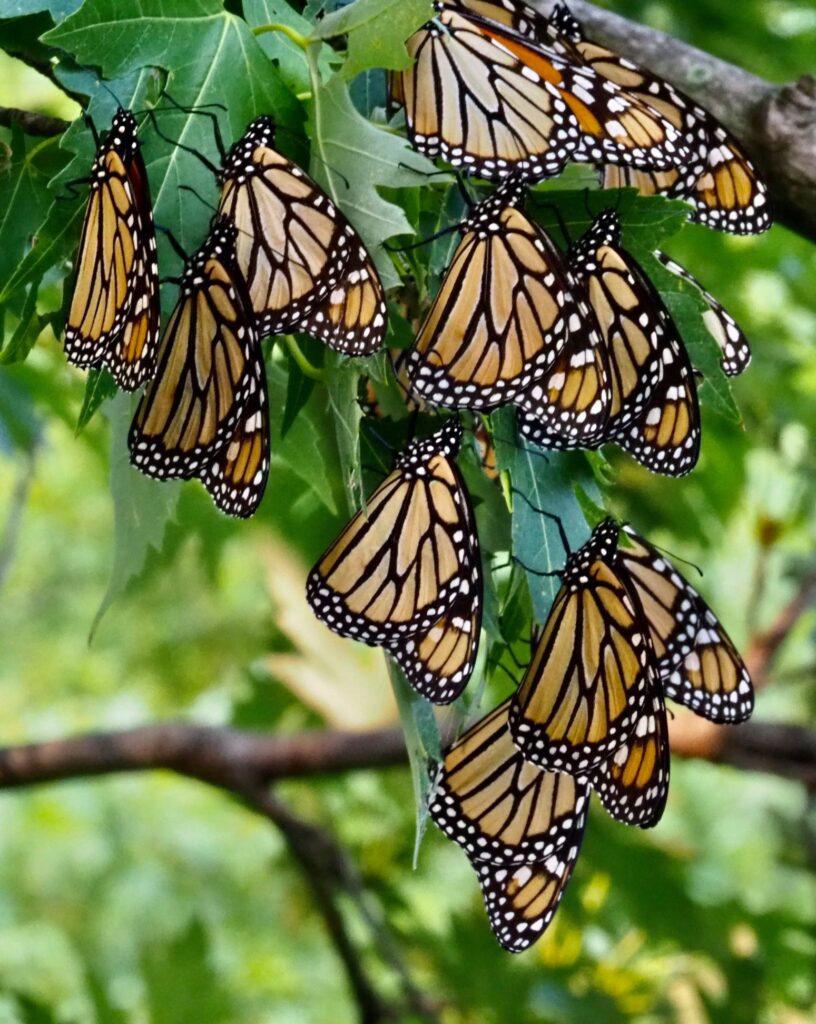
Big Numbers
The monarch numbers I observed on Monday, 9/21/2020 seemed to me to be more stunning than I can ever remember. I estimated conservatively in a report to Journey North, there were at least 500 monarchs resting in the Arboretum that day. But after giving it more consideration and talking to a local monarch tagger, Karen Fulk, I wonder if that number was more accurately in the thousands.
Karen’s many years of efforts to tag monarchs in Hesston has her keenly in touch with monarch phenology and migration patterns. She reports that the peak of migration through south central Kansas is usually between 9/22 and 9/27. This year, however, she started seeing an uptick in numbers when a cold front and north wind jump-started the southerly monarch migration a bit earlier.
Karen usually tags 300 annually during the fall migration. This year, Chip Taylor at Monarch Watch, knowing that migration numbers were higher this year, suggested that taggers order extra tags. Karen increased her number to 500 tags and was able to apply most of those when the fallout began Friday 9/18/2020 through Sunday 9/20/2020. Arboretum member, Gerry Epp, further documented this event by posting photos of the fallout on his Facebook page, 9/20/2020.
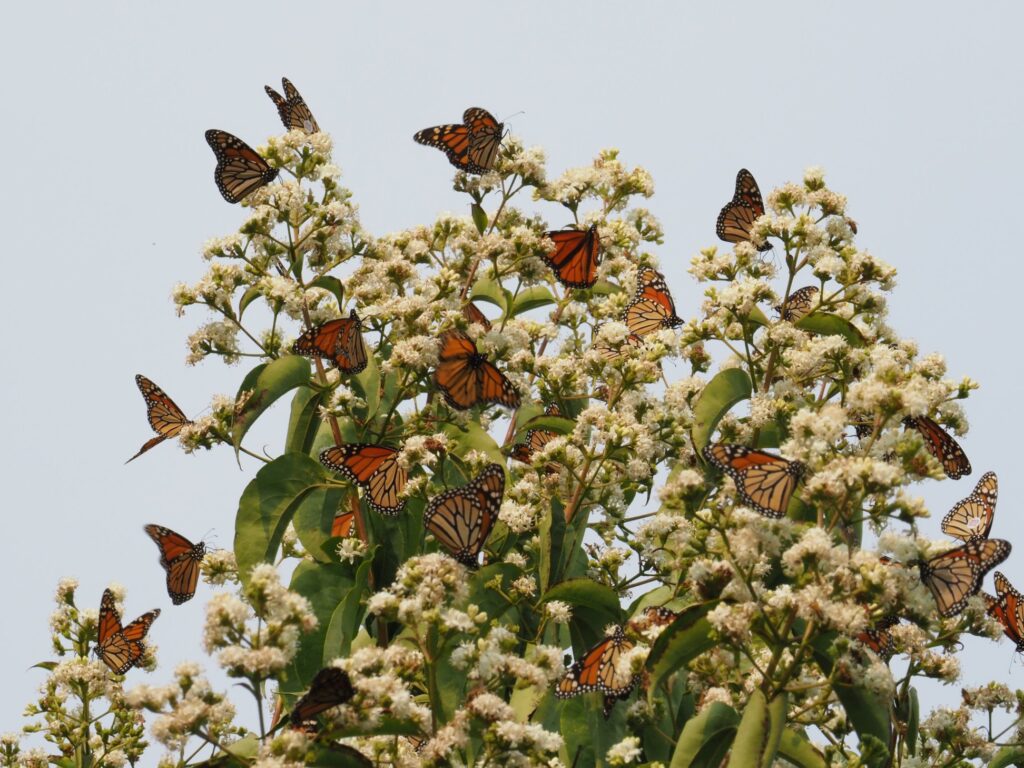
Fallout Location
With some repetition now in seeing these fallouts occur in the same place, I want to give some thought to why they congregate where they do at Dyck Arboretum. Karen usually tags at three places in Hesston based on the ability to catch and tag the maximum number in one place, and Dyck Arboretum is where she does the majority of her work. She estimated that 95% of her tagging this year happened at the Arboretum, based on seeing the greatest number of butterflies here.
I would hypothesize that they repeatedly congregate in the small 1/8th-acre area at the Arboretum amphitheater/pinetum for three reasons. One, they are seeking protection from the elements of wind and heat. This is about energy conservation. By escaping the wind and congregating in large groups on the north side of the dense hedge row of Osage orange trees, they are finding a microclimate that is cooler, more humid, and less turbulent than they would find on the south side.
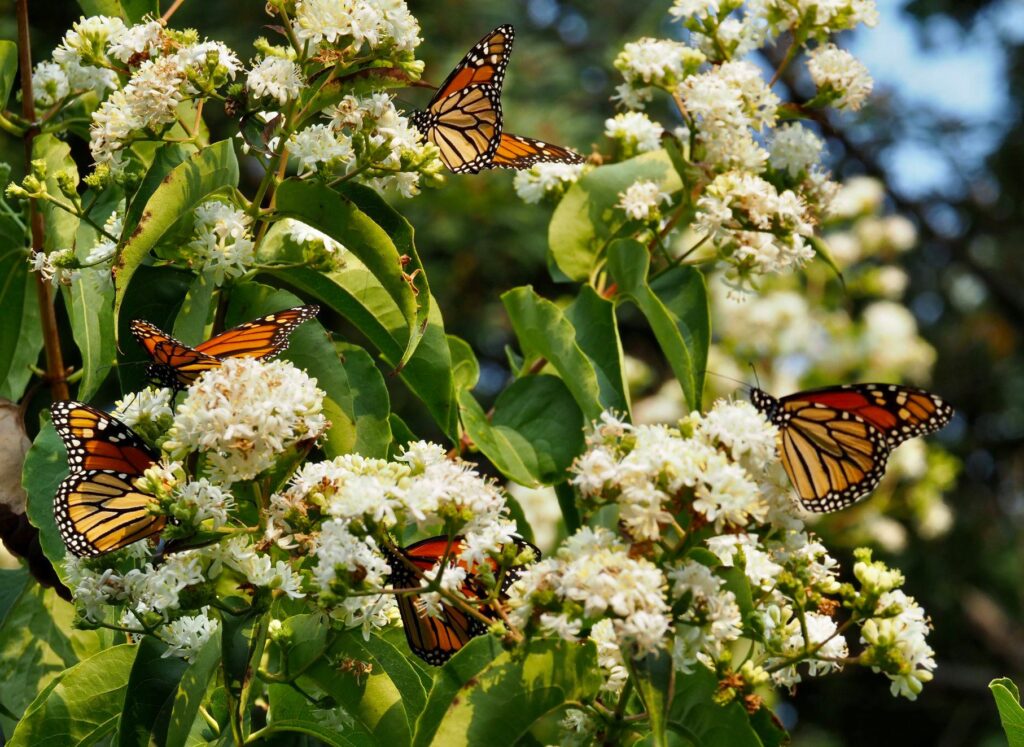
Two, this location is next to a number of nectar sources. Why not rest where you can eat/drink too? Nearby native plant beds and a reconstructed prairie had a timely profusion of flowering from many species of the genera Helianthus (sunflower), Solidago (goldenrod), Symphotrichium (aster), Liatris (gayfeather), Eryngium (eryngo), and Heptacodium (seven son flower).
Three, a number of white pines in this location may resemble the trees of the Oyamel fir forests in Mexico. I don’t have any proof of this theory, but it seems plausible to me.
Predator Story
The newest wrinkle of this monarch fallout experience was the side story of five immature Mississippi kites. They were probably migrating with the monarchs and decided also to not fight the strong south wind. For a day and a half that I observed, this hungry bunch of pentomic predators took advantage of an abundant food supply. They hung out in the top of one of the white pines and took turns swooping through the monarch clouds to easily catch a snack.
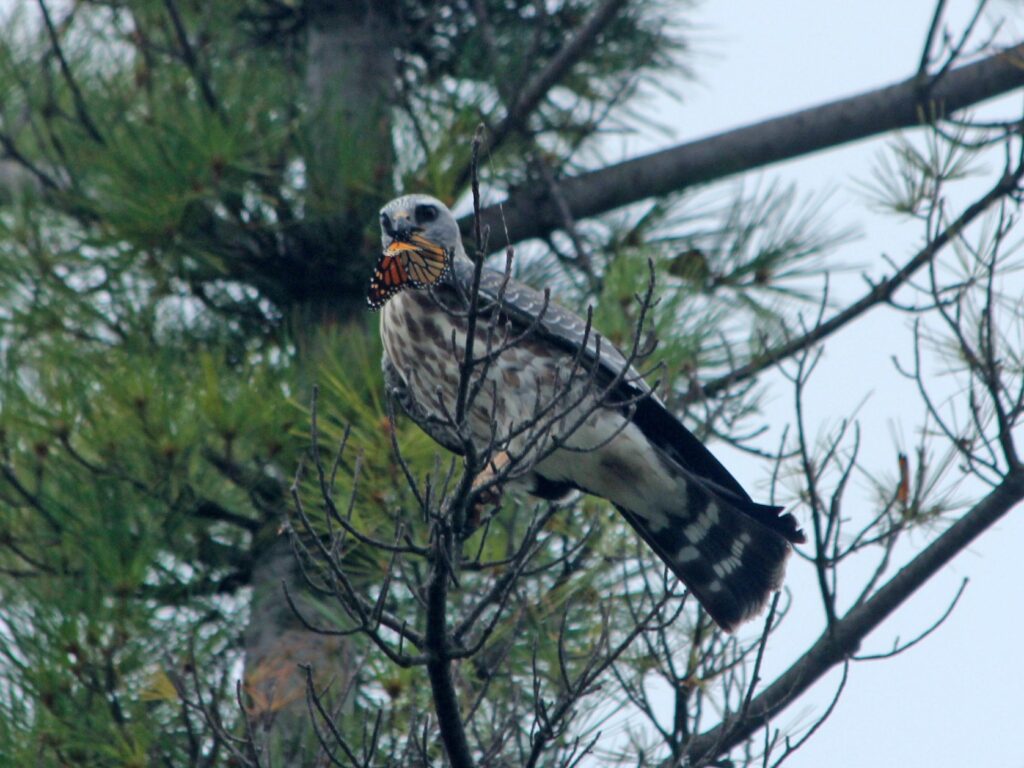
Sometimes they missed catching their target, but usually, these agile insect catchers snagged their prey. Typically they would return to their perch to eat their catch, but sometimes they would eat in flight or “on the wing” as I hear experienced birders say. At one point, I counted approximately 120 monarch wings that had fluttered down to form what I’ll call a monarch confetti debris field. At four wings per monarch, that represented the carnage of about 30 monarchs. However, a number of wings had already been collected by onlookers, so it is not unreasonable to think that the number of monarchs preyed upon were double or triple what I saw.
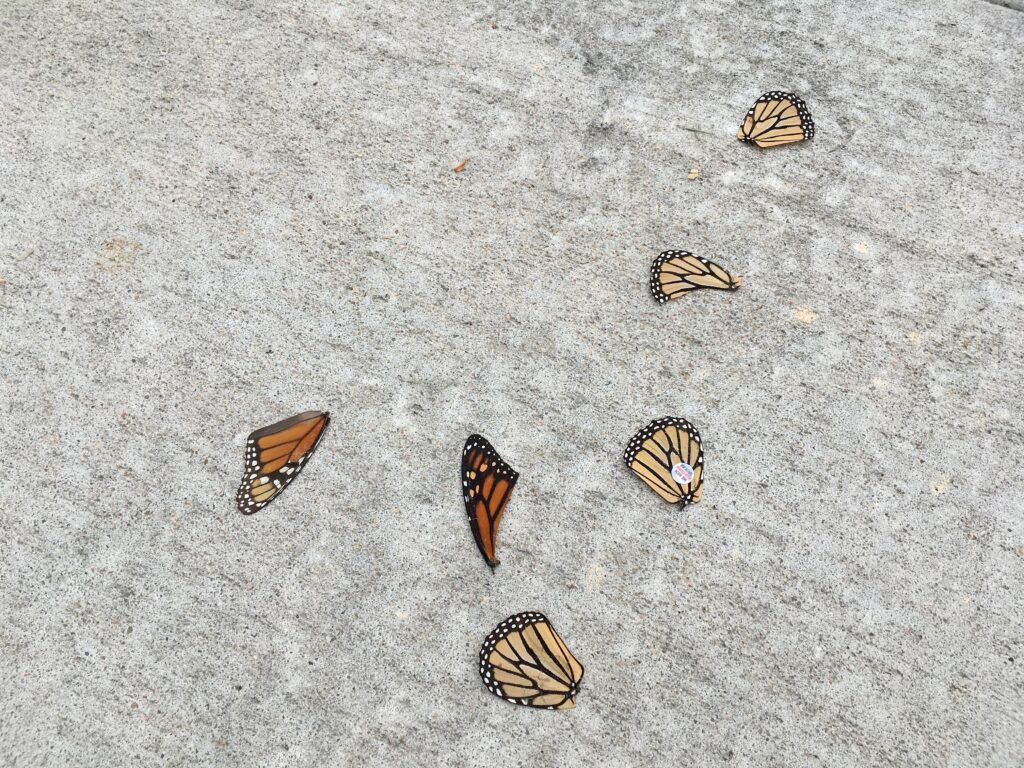
Monarch Toxicity
This predator behavior was a surprising observation. Monarch larvae eat milkweed and sequester in the mature butterfly wings and exoskeleton the milkweed toxins called cardiac glycosides. These heart poisons can seriously affect vertebrate predators, including birds, and often cause them to vomit and subsequently avoid eating them further. However, these young kites not only ate monarchs all day Monday, but they continued their feeding frenzy the next morning. Either their stomachs weren’t too adversely soured, or the calories needed to continue this migratory journey were simply too important.
A Google literature review turned up no articles mentioning this habit of Mississippi kites eating monarchs. However, a follow-up conversation with University of Kansas biology instructor, Brad Williamson, helped me understand that this observation is not so irrational. He explained that the monarch population is not 100% toxic.
“The individual toxicity depends a lot on the particular milkweed species that hosted the larval stage. Asclepias syriaca (common milkweed) and Cynanchum laeve (honeyvine milkweed) are not nearly as toxic as A. verticillata (whorled milkweed). There is an entire range of toxicity and it makes for some great mathematical modeling questions–just how much toxicity (percent toxic) in the population is necessary for protection for the entire population? How much metabolic costs are there for monarchs trying to process highly toxic host plants? Turns out that only 25-40% of the population being toxic confers protection for the remaining population.” (I will include below a bibliography on monarch toxicity that Brad Williamson provided if any of you are interested as I am in learning more about this topic.)
There were a lot of interesting biological and ecological issues at play here with these monarchs and kites. It was just one more interesting natural history story with subplots to be observed by those of us living in the Monarch Flyway. Until I’m able to one day witness the hundreds of millions of monarchs wintering in the the Oyamel forests of central Mexico, I am completely content having a front row seat to this fascinating migration phenomenon right here in Kansas.
Plant Milkweed
To assist the monarchs and their annual migration, plant milkweed host plants and other native nectar plants for adults. Check out our annual spring and fall Flora Kansas native plant sales.
Articles on Monarch Toxicity
- Brower, L. P., and C. M. Moffitt. “Palatability Dynamics of Cardenolides in the Monarch Butterfly.” Nature 249, no. 5454 (1974): 280–283.
- Brower, Lincoln P. “Avian Predation on the Monarch Butterfly and Its Implications for Mimicry Theory.” The American Naturalist 131 (1988): S4–S6.
- Brower, Lincoln P., and Susan C. Glazier. “Localization of Heart Poisons in the Monarch Butterfly.” Science 188, no. 4183 (1975): 19–25.
- Brower, Lincoln P., Peter B. McEvoy, Kenneth L. Williamson, and Maureen A. Flannery. “Variation in Cardiac Glycoside Content of Monarch Butterflies from Natural Populations in Eastern North America.” Science 177, no. 4047 (1972): 426–429.
- Fink, Linda S., and Lincoln P. Brower. “Birds Can Overcome the Cardenolide Defence of Monarch Butterflies in Mexico.” Nature 291, no. 5810 (1981): 67–70.Malcolm, S. B., and L. P. Brower. “Evolutionary and Ecological Implications of Cardenolide Sequestration in the Monarch Butterfly.” Experientia 45, no. 3 (1989): 284–295.
- Malcolm, Stephen B. “Milkweeds, Monarch Butterflies and the Ecological Significance of Cardenolides.” Chemoecology 5, no. 3–4 (1994): 101–117.
- Malcolm, Stephen B., Barbara J. Cockrell, and Lincoln P. Brower. “Cardenolide Fingerprint of Monarch Butterflies Reared on Common Milkweed, Asclepias Syriaca L.” Journal of Chemical Ecology 15, no. 3 (1989): 819–853.
- Nelson, C. J., J. N. Seiber, and L. P. Brower. “Seasonal and Intraplant Variation of Cardenolide Content in the California Milkweed, Asclepias Eriocarpa, and Implications for Plant Defense.” Journal of Chemical Ecology 7, no. 6 (1981): 981–1010.
- Roeske, C. N., J. N. Seiber, L. P. Brower, and C. M. Moffitt. “Milkweed Cardenolides and Their Comparative Processing by Monarch Butterflies (Danaus Plexippus L.).” In Biochemical Interaction between Plants and Insects, 93–167. Springer, 1976.
- Zalucki, Myron P., Lincoln P. Brower, and Alfonso Alonso-M. “Detrimental Effects of Latex and Cardiac Glycosides on Survival and Growth of First-Instar Monarch Butterfly Larvae Danaus Plexippus Feeding on the Sandhill Milkweed Asclepias Humistrata.” Ecological Entomology 26, no. 2 (2001): 212–224.
